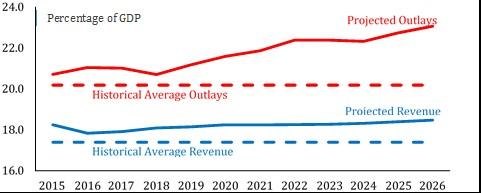Six New, Scary Equations from the Congressional Budget Office
1. (Revenues > Historical Average) + (Spending MUCH > Average) = $1 T Deficits
|
Over the past 50 years, average revenues were 17.4% of the economy’s Gross Domestic Product (GDP), while spending averaged 20.2%. CBO expects revenues to remain above the historical average, but spending will far outpace its average. [1] As a result, trillion-dollar deficits will return in 2024, a level only previously seen during the first four years of the Obama presidency.[2] |
 |
2. Mandatory Spending + No Reforms = 70% Hike in Mandatory Spending
| Without reforms, CBO projects that mandatory spending will increase by 70% over the decade.[3] In fact, mandatory spending and interest on the debt will consume over 96% of revenues by 2026, crowding out important priorities like national defense and forcing massive government borrowing.[4]
|
3. Growing Interest Rates + Growing Deficits = 3X Interest Payments on Debt
|
A weak economy caused CBO to delay the projected rise in interest rates, but CBO still predicts that with rising rates and growing deficit spending, interest payments on the national debt will nearly triple over the decade, from $248 billion in 2016 to $712 billion in 2026.[5] In fact, borrowing costs will virtually tie with national defense as our third largest spending program. Other than major health programs and Social Security, interest on the debt will grow more quickly than all other government programs combined. |
4. Growing Debt + Inaction = Likely Fiscal Crisis + Shrinking Paychecks
| The national debt under President Obama has nearly doubled to an astounding $19.4 trillion.[6] The portion of the debt owed to U.S. and foreign investors now represents the largest share of the economy since 1950, and it is on track to hit the highest level in recorded history.[7] CBO warns that the current debt trajectory risks a financial crisis in which investors would become increasingly unwilling to finance government borrowing. High and rising debt also takes a bite out of worker paychecks. As CBO explains, “Because federal borrowing reduces total saving in the economy, the nation’s capital stock would ultimately be smaller, and productivity and total wages would be lower.”[8] |
5. Slower Growth = $4 Trillion Missing from Economy
In January, CBO projected economic growth of 2.5% this year with average growth of 2.1% over the decade. Given the slow growth during the first half of 2016 and other economic conditions, CBO lowered its projections to 1.9% this year with average growth below 2% for the next 10 years. This new downgrade means that over the decade, a total of over $4 trillion will be missing from the economy compared to the January estimate. The downgrade also lowered revenue projections by $428 billion over the decade.[9]
6. Obamacare + Tax Code = Fewer Americans Working
CBO notes that federal policies have contributed to America’s shrinking workforce by discouraging Americans from working or seeking work.[10] A larger paycheck pushes people into paying higher tax rates. Earning more also causes them to lose insurance subsidies that help them pay for rising Obamacare premiums.[11] Together, the outdated tax code and Obamacare are deterring Americans from reaching their full earning potential.
[1] “An Update to the Budget and Economic Outlook: 2016 to 2016,” Congressional Budget Office, August 2016, Page 11. https://www.cbo.gov/sites/default/files/114th-congress-2015-2016/reports/51908-2016_Outlook_Update-2.pdf